Sedona, Arizona: A Place of Spiritual Awakening
As I began to jog through my memory to see if I have actually had the opportunity to be in an area of tranquility and enlightenment, I honestly could not think of an area that could do just that to me. However, I do remember being a very young child and traveling with my parents to the Grand Canyon and always wanting to go back to Arizona and be once again, surrounded by nature and beauty. This is when I came across the breathtaking city of Sedona, Arizona. I have personally never visited this area, but I have been told by many that I must visit this city. Sedona has a well-known reputation as a spiritual mecca, where many view it as the perfect place for spiritual and personal enrichment of the body and the soul. Sedona is held to be a sacred place by the local Native Americans, referred to as the Yavapai. Sedona is seen as a place of emergence of the goddess Komwidapokuwia (or Kamalpukwia), which means, “first people with medicine” or “old lady rock” (Coppens).
The red rock scenery and evergreen vegetation are just two of the many reasons that give inspirational effects to its onlookers. The infamous red-orange color of the rock is believed to be one of the most neuro-stimulating of colors, enhancing one’s creative thinking and problem solving. The geology of Sedona is an impressive array of rock formations which have been laid down from processes of high wind deserts to the many times we have been underwater as inland seas or the ocean. These processes have left behind a layer cake of rock formations. The bottom red layer, on which much of Sedona is built, is a sandstone layer, which is comprised primarily of the most abundant crystal on the planet, which is quartz. Many Indigenous healers and, in their work, use quartz as a healing tool, for they believe it serves to amplify energy and open up the spiritual doors for ceremony. The element that gives the rocks their radiating red color is iron and when exposed to the elements, turn the rocks red (Inner Journeys 2010). Sedona is also always surrounded by bright green vegetation, which many also believe gives a sense of hope and renewal to visitors (Sanders et. al. 2012). I have always been told that colors do have a psychological effect on people, with certain colors allowing for a more depressed and sad mood for those that are constantly surrounded by it, while other colors are more uplifting and peaceful. The trails allow for many opportunities of prayer and reflection for those trying to escape the hustle and bustle of cities that more often than not, tend to over stimulate and stress those people that are constantly surrounded by it. The picture below is just one of many that captures the amazing rock formation and the color, which reminds me of a sunset and gives that tranquil feeling, even from just staring at this picture, so I can only imagine the effects that it has on those standing in front of this scenery.
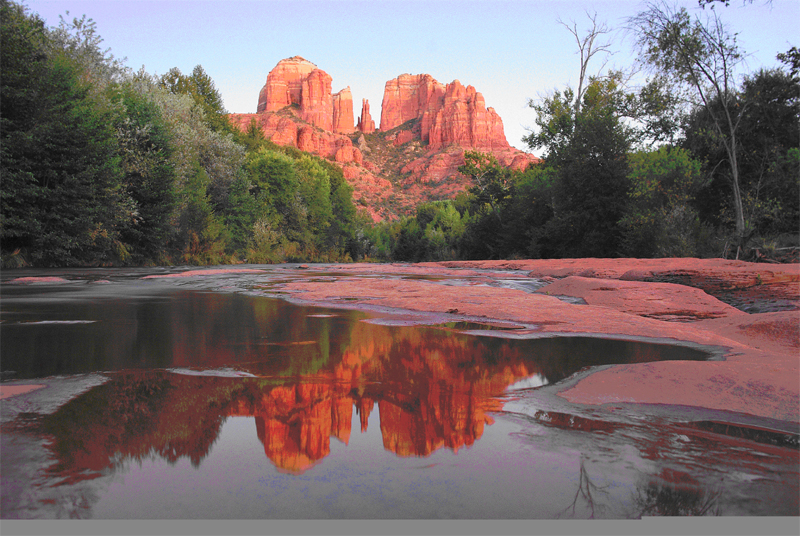
There are many different areas to go when in Sedona, some of which have an amazing history behind it, and no matter what religion one may practice, once here, people can sense that they are welcome and can feel comfort in knowing that they can pray here and feel their Higher Power. Hundreds of thousands of people from all over the world travel here to experience spiritual/physical healing and to expand their consciousness. Many claim to leave Sedona a changed person, from either having experienced a miraculous healing or from just being inspired from the beautiful landscape (Peck 2010).
One of the “must see” sights of Sedona is the Chapel of the Holy Cross. “More than half a century after its construction, the Chapel of the Holy Cross continues to be a place of wonder, spiritual renewal, and sublime vistas for all who come to Sedona” (Somerville 2008).
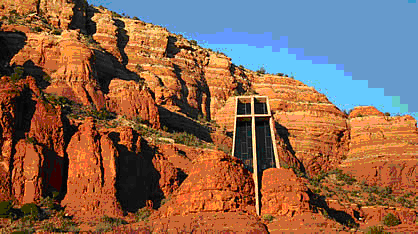
This is one of many views of the chapel, which appears to become part of the surrounding rocks, which is just beyond mesmerizing. The chapel sticks out of two red mounds on a piece of rock that is 200 feet above the ground. Surrounding the chapel are the Mystic Hills, which are filled with ancient, sacred imagery. These energy-rich red-rock formations, which some people claim are a vortex, embrace the chapel in an arc from behind (Somerville 2008). As I stated before, the architecture of this chapel makes it become a part of nature and history, almost as if the rocks are embracing the chapel, and for some people, this escape from the chaos of life allows them to feel closer and more at peace with their Higher Power. The Chapel’s most prominent feature is a cross, where from the side, it looks like it was dropped into place from above, resembling and path where one can leap towards spirit. The interior of the chapel is very simple and intimate, with no adornments. However, no matter what position one is in while inside of the chapel, the person is immediately drawn to the cross in the center (Somerville 2008). The Chapel of the Holy Cross was a gift from Marguerite Brunswig Staude, which was completed in 1956, and she envisioned “That the church may come to life in the souls of men and be a living reality—herein lies the whole message of the chapel.” Within the year of 1957, the Chapel of the Holy Cross gained national recognition and was honored with the prestigious AIA National Award for religious structures (Somerville 2008).
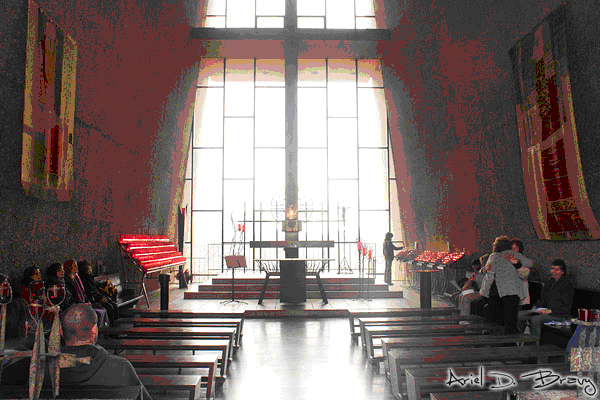
As one can see, the beauty of this chapel lies in its simplicity, and the sun glowing through the windows while one is kneeling and praying, gives a sense of spiritual cleansing and as if one is looking directly into the sky and talking to their Higher Power, which in some cases, is God. No regular services are held within the chapel, for it is meant to be a place of reflection and meditation for all those who come. Visitors are greeted by a sign marking the entrance, which reads, “Peace to all who enter.” The interior is very simple, with nothing more than a few pews and an alter, for the sole purpose of not having attention being taken away from the spiritual inflection and physical block glass windows and large cross that emphasize the space (Sveiven 2011). Some people even see the Chapel of the Holy Cross to be one of the most beautiful architectural pieces in the state of Arizona.
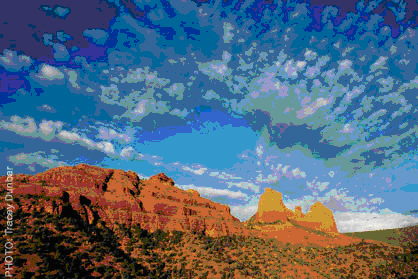
Sedona Vortex sites are very popular tourist attractions. These Sedona Vortex sites are enhanced energy locations that facilitate prayer, meditation, mind/body healing, and exploring one’s relationship with one’s Soul and the divine. They are neither electric nor magnetic, but rather simply stated; vortex sites are locations having energy flows in those deeper dimensions that the Soul can soar on (Sanders et. al. 2012). These vortices allow people to explore their relationship within their surrounding communities and allow one to restore their balance of wellbeing.
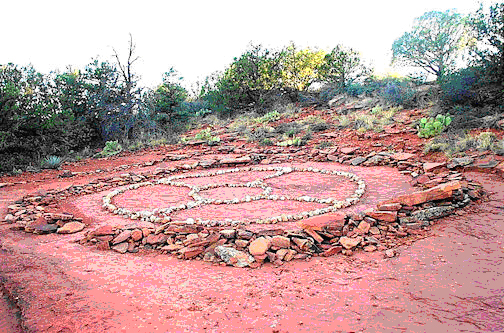
Sedona has become a melting pot of different cultures where the sacred tools of these cultures are available for others to use so that they may too explore their spirituality. Many people seem to resonate with Native American teachings because they are often times based on understanding one’s connection to a living Earth where humans are only a very small part. These teachings bring an awareness of blending the spiritual world into the workings of one’s everyday life, and one such teaching that occurs very frequently in Sedona, is the use of the Medicine Wheel. The above picture shows a Medicine wheel and the formation of one that is used during a ceremony. Although the Medicine Wheel has Native American roots, which may differ from some people’s religious beliefs, it is seen as a ceremony that allows for self- discovery, healing, spiritual seeking and/or reconnecting to the Earth. The Medicine Wheel is full of symbolism as it consists of an equidistant cross within a circle, which represents the wholeness and unity of all life and, as one steps inside the circle, they come into relationship with all life. This realization of inner unity is an important aspect of the healing process as it dissolves the idea of separation. The circle has no beginning and no end so that it becomes a symbol of constant change and a realization of being able to flow with the energies of life that exist all around us. Both the spiraling vortex and circle are symbols that help bring awareness to all towards the constant flowing energies of life (Inner Journeys 2010).
When one visits Sedona, it does not matter what prior beliefs one may have, but upon entering this beautiful, welcoming area, one cannot help but feel rejuvenated and at peace once there. We live in a world that is surrounded by buildings and noise and barely any type of natural vegetation, so by traveling to Sedona and really taking in the view of the rock formations and the different methods of spiritual enhancement and personal healing, one may get this sense of Spiritual Awakening.
Works Cited
Coppens, Phillip. "The power of Sedona." Philip Coppens.com. Web. 30 Sept. 2012. <http://www.philipcoppens.com/sedona.html>.
Peck, Jeffrey. "Spiritual awakening in Sedona, Arizona - Phoenix Holistic Spirituality | Examiner.com." Welcome to Examiner.com | Examiner.com. 6 Dec. 2010. Web. 1 Oct. 2012.
<http://www.examiner.com/article/spiritual-awakening-sedona-arizona>.
"Sacred Places of Sedona, Arizona." Spiritual & Energy Healing | Vortex Tours & Retreats |Sedona, Arizona. 2010. Web. 28 Sept. 2012. <http://www.innerjourneys.us/sedona_information/sacred_places_of_sedona_arizona.php>.
Sanders, Pete, and David Cates. "Personal and Spiritual Enrichment: Relaxation | Rejuvenation." Sedona Arizona Vacation. 2012. Web. 28 Sept. 2012. <http://www.visitsedona.com/article/151>.
Somerville, Sylvia. "Chapel of the Holy Cross." Sedona Arizona Visitor Guide - Lodging, Tours and Attractions - Gateway To Sedona. 29 June 2008. Web. 28 Sept. 2012. <http://www.gatewaytosedona.com/article/id/83/page/1>.
Sveiven, Megan. "AD Classics: Chapel of The Holy Cross/Richard Hein." ArchDaily. 27 Apr. 2011. Web. 28 Sept. 2012.
